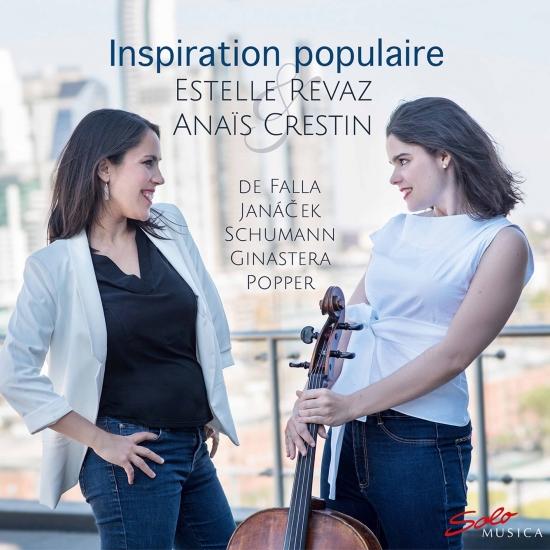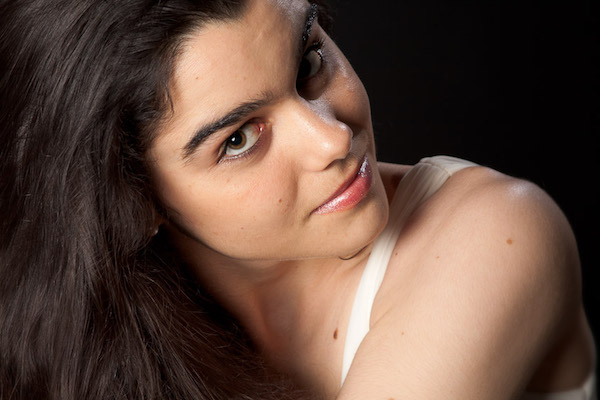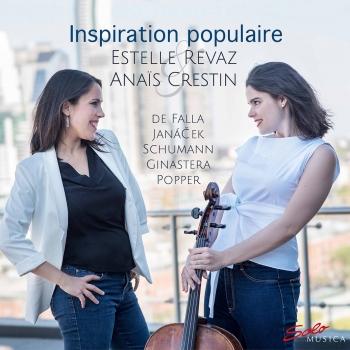
Inspiration populaire Estelle Revaz & Anaïs Crestin
Album info
Album-Release:
2022
HRA-Release:
04.03.2022
Label: Solo Musica
Genre: Classical
Subgenre: Chamber Music
Artist: Estelle Revaz & Anaïs Crestin
Composer: Manuel de Falla (1876-1946), Leos Janacek (1854-1928), Robert Schumann (1810-1856), Alberto Ginastera (1916-1983), David Popper (1843-1913)
Album including Album cover
- Manuel de Falla (1876 - 1946): 7 Canciones populares españolas, G. 40 (Excerpts Arr. M. Maréchal for Cello & Piano):
- 1Falla: 7 Canciones populares españolas, G. 40 (Excerpts Arr. M. Maréchal for Cello & Piano): No. 1, El paño moruno02:23
- 2Falla: 7 Canciones populares españolas, G. 40 (Excerpts Arr. M. Maréchal for Cello & Piano): No. 5, Nana02:35
- 3Falla: 7 Canciones populares españolas, G. 40 (Excerpts Arr. M. Maréchal for Cello & Piano): No. 6, Canción01:32
- 4Falla: 7 Canciones populares españolas, G. 40 (Excerpts Arr. M. Maréchal for Cello & Piano): No. 7, Polo01:17
- 5Falla: 7 Canciones populares españolas, G. 40 (Excerpts Arr. M. Maréchal for Cello & Piano): No. 3, Asturiana02:23
- 6Falla: 7 Canciones populares españolas, G. 40 (Excerpts Arr. M. Maréchal for Cello & Piano): No. 4, Jota03:06
- Leoš Janáček (1854 - 1928): Pohádka, JW VII/5:
- 7Janáček: Pohádka, JW VII/5: I. Con moto05:11
- 8Janáček: Pohádka, JW VII/5: II. Con moto03:51
- 9Janáček: Pohádka, JW VII/5: III. Allegro02:53
- Robert Schumann (1810 - 1856): 5 Stücke im Volkston, Op. 102:
- 10Schumann: 5 Stücke im Volkston, Op. 102: I. Vanitas vanitatum. Mit humor03:26
- 11Schumann: 5 Stücke im Volkston, Op. 102: II. Langsam03:41
- 12Schumann: 5 Stücke im Volkston, Op. 102: III. Nicht schnell, mit viel Ton zu spielen03:45
- 13Schumann: 5 Stücke im Volkston, Op. 102: IV. Nicht zu rasch02:03
- 14Schumann: 5 Stücke im Volkston, Op. 102: V. Stark und markiert03:14
- Alberto Ginastera (1916 - 1983): Cello Sonata, Op. 49:
- 15Ginastera: Cello Sonata, Op. 49: I. Allegro deciso07:08
- 16Ginastera: Cello Sonata, Op. 49: II. Adagio passionato05:38
- 17Ginastera: Cello Sonata, Op. 49: III. Presto mormoroso02:56
- 18Ginastera: Cello Sonata, Op. 49: IV. Allegro con fuoco03:51
- David Popper (1843 - 1913): Hungarian Rhapsody, Op. 68:
- 19Popper: Hungarian Rhapsody, Op. 6807:17
Info for Inspiration populaire
Folk music and dance have always been a source of inspiration for art music as they keep in touch with people's souls. Nonetheless, composers' tendency towards a universal musical language has considerably diluted the ethnic character they contain, a phenomenon particularly noteworthy in Europe. In the 18th century, the artistic tendency to emphasize exotic colors and charms arose. Composers began to use foreign folklore to spice up their works with unfamiliar sounds, for example the Rondo alla Turca in Wolfgang Amadeus Mozart's Piano Sonata in A major. At the same time there was also a political increase in nationalism and every country, every ethnic group also strived to to distinguish himself from his neighbors with his own music. This trend is often an expression of the desire for the emancipation of oppressed people. The rules of classical music, until then strictly standardized, now had to integrate the characteristics of melody and rhythm of folk music, be it in tonality, meter or structure. If this emergence of folk inspiration is related to social developments, it may also touch the listener more directly. In addition, composers, sometimes far from home, have the opportunity to remain connected to their cultural roots, as we shall see with Alberto Ginastera. now had to integrate the qualities of melody and rhythm of folk music, be it in tonality, meter or structure. If this emergence of folk inspiration is related to social developments, it may also touch the listener more directly. In addition, composers, sometimes far from home, are given the opportunity to stay connected to their cultural roots, as we shall see with Alberto Ginastera. now had to integrate the qualities of melody and rhythm of folk music, be it in tonality, meter or structure. If this emergence of folk inspiration is related to social developments, it may also touch the listener more directly. In addition, composers, sometimes far from home, are given the opportunity to stay connected to their cultural roots, as we shall see with Alberto Ginastera.
Estelle Revaz and Anaïs Crestin met in 2012 at the Mendoza International Festival in Argentina. Similar career paths through French and German conservatoires naturally facilitated a relationship, both human and musical. Since then they have performed regularly together in South America and Europe. The "Inspiration populaire" project, realized in the midst of the Covid-19 pandemic, has further encouraged their creativity and collaboration.
Estelle Revaz, cello
Anaïs Crestin, piano

Estelle Revaz
Born in Switzerland in 1989, the cellist Estelle Revaz benefited from an international musical career at a very young age. After starting out in her home country, she studied with Jérôme Pernoo at the Conservatoire National Supérieur de Musique et de Danse in Paris. She continued her studies at the Musikhochschule in Cologne with Maria Kliegel, who was able to pass on her wealth of experience as a concert cellist to her. Winner of several important prizes and supported by several music foundations, Estelle Revaz was able to gain international stage experience in Europe, Asia and South America very early on.
Estelle Revaz's solo performances with orchestra have been highly acclaimed by audiences and the press; her wide-ranging repertoire ranges from baroque concerts to world premieres of contemporary compositions. From 2017, Estelle Revaz will be the soloist in residence with the Orchester de Chambre de Genève under the baton of Arie van Beek for the next three seasons.
As an equally enthusiastic chamber musician, Estelle Revaz has a special fondness for duo recitals (cello-piano) and trio formations. Her performances have taken her to well-known concert halls such as the Victoria Hall in Geneva, the Paul Klee Center in Bern, the Martinskirche in Basel, the Salle de Musique in La Chaux-de-Fonds, the Louvre in Paris, the NCPA in Beijing or the Oriental Art Center of Shanghai. Her musical partners include Gautier Capuçon, Lena Neudauer, Pavel Vernikov, Sergey Ostrovsky, the Quatuor Sine Nomine, Finghin Collins, Gérard Wyss and Christian Chamorel.
In 2015, NEOS music released her album CANTIQUE as a co-production with Radio Télévision Suisse, which was enthusiastically celebrated by the international press. For this recording, Estelle Revaz recorded Ernest Bloch's Hebrew rhapsody "Schelomo" and Andreas Pfluger's concerto "Pitture" with the Orchester Musique des Lumières conducted by Facundo Agudin, which was written especially for her.
Since 2015, Estelle Revaz has been a member of the "Forum des 100": 100 personalities who represent the future of Switzerland.
Anaïs Crestin
was born in the region of Vandea, France. As a soloist or with various chamber music groups, Anaïs is invited by many countries with an immense musical tradition, delighting her audiences with her personal style in performance. Different stages all around the world have seen her play masterfully: France, Germany, UK, Switzerland, Greece, Argentina, Brazil, Bolivia, Colombia, Ecuador, Uruguay, Chile.
In 2007, she moved to Argentina, where she discovered the music of the great Latin American composers. At first, she worked as a pianist for the manent choir at the Colón Theater and, afterwards, as a teacher and pianist for the prestigious theatre's Philharmonic.
Her road is made by walking, and that tapestry of cultures and countries lead her in a permanent discovery. She was part of the Buenos Aires Philharmonic, the National Orchestra of Argentine Music, the Argentine National Symphony Orchestra, the Orchestra of the Guadalquivir Festival in Bolivia and, during her years as a student, the German National Orchestra. She is a professor at the UNA (University of Arts) and the Conservatory of the City of Buenos Aires.
In her tours, she performs with many prominent and internationally recognized musicians: Ophélie Gaillard, cello; Sophie Kulsmann, singer; Claude Delange, saxophones; Carlos Céspedes and Estelle Revaz, cello; Matías Villafane, cello; Luis Rossi and Ronald Van Spaendonck, clarinet; Sarah Rumer, Julien Szulman violin.
In 2020, she will be director of the International Beethoven Festival together with Dora de Marinis.
This album contains no booklet.











